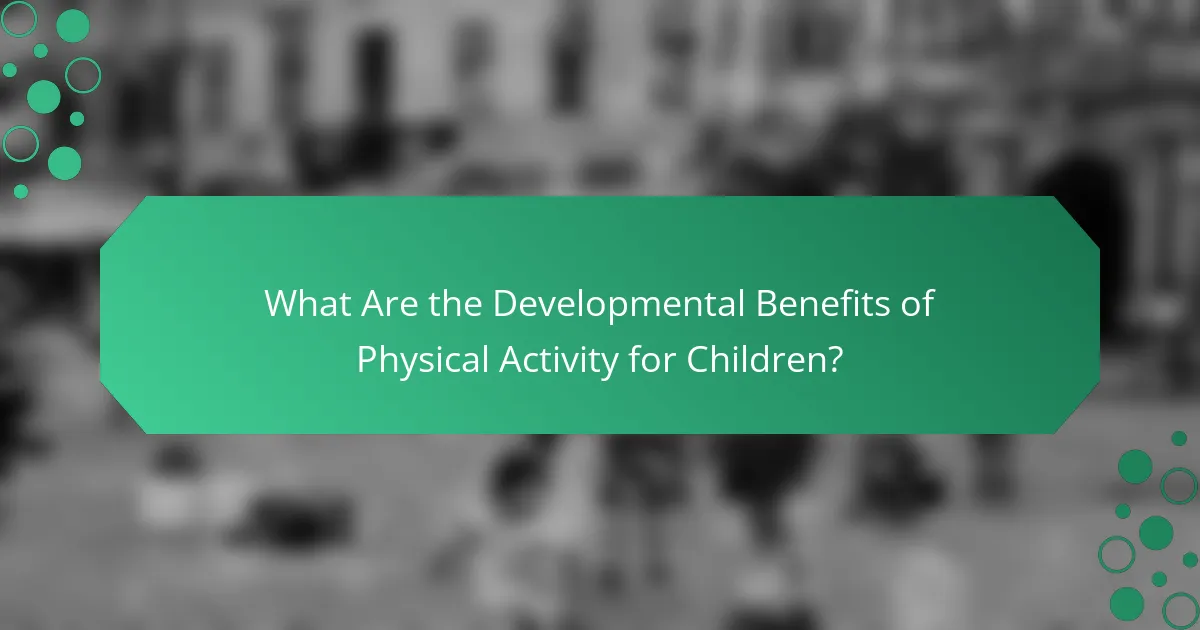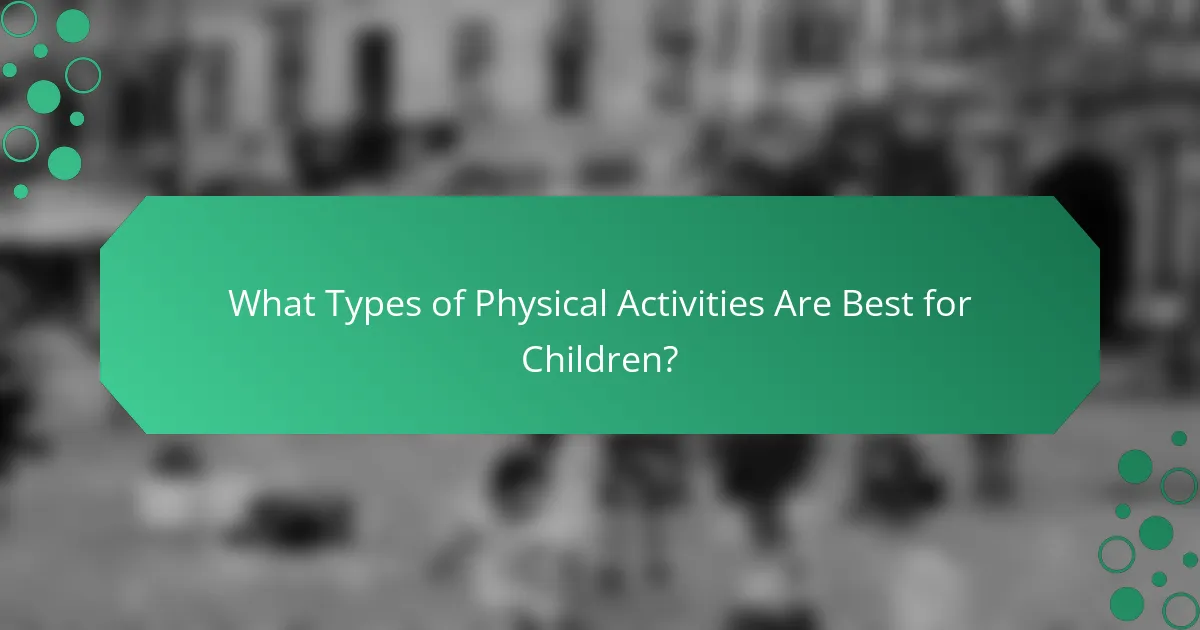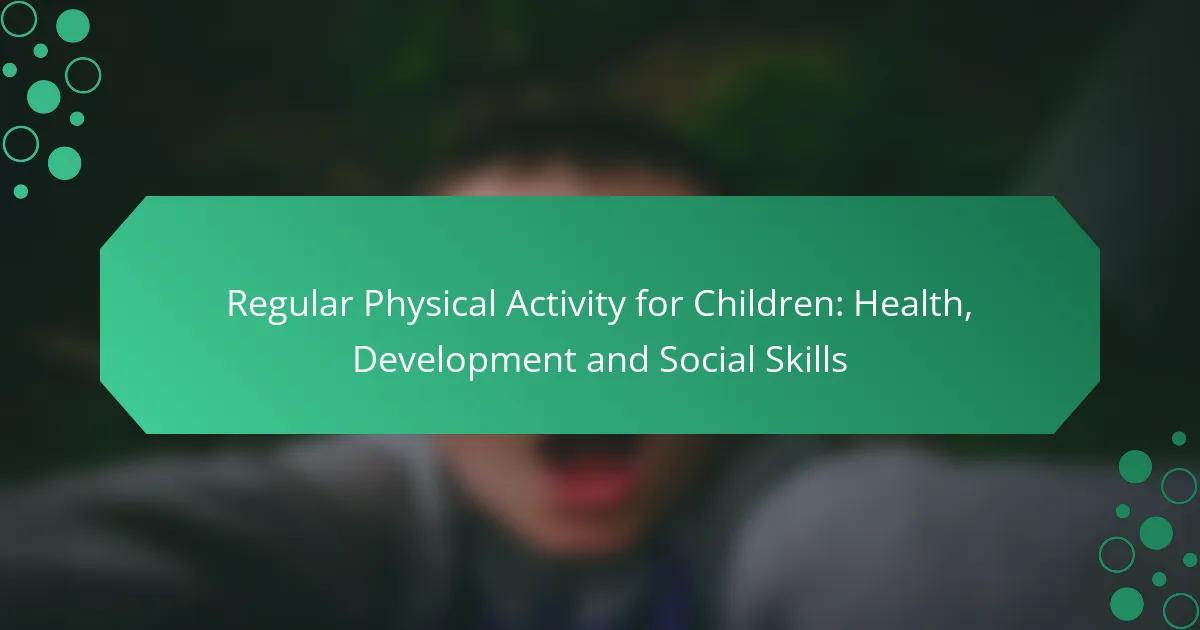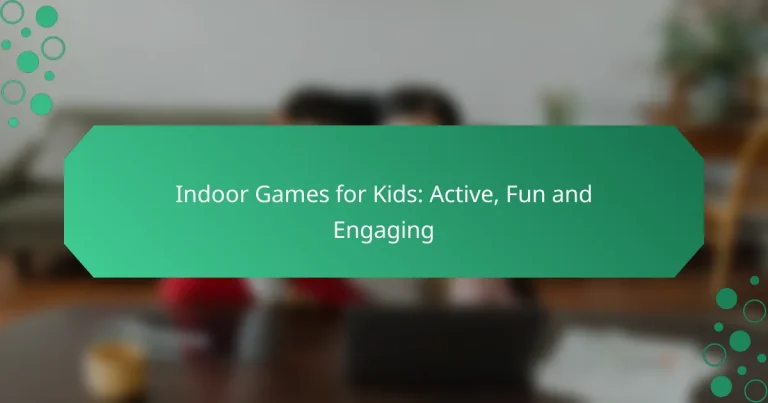Regular Physical Activity for Children: Health, Development and Social Skills
Regular physical activity is vital for children’s health, development, and social skills. It not only boosts physical fitness and mental well-being but also fosters essential cognitive and emotional growth. Through engaging in exercise, children enhance their strength, coordination, and social interactions, laying the foundation for a healthier and more connected future.

How Does Regular Physical Activity Benefit Children’s Health?
Regular physical activity significantly enhances children’s health by improving their physical fitness, supporting their immune systems, and fostering mental well-being. Engaging in consistent exercise can lead to a healthier lifestyle and reduce the risk of various health issues.
Improves cardiovascular health
Engaging in regular physical activity strengthens children’s hearts and improves blood circulation. Activities like running, swimming, or cycling can enhance cardiovascular endurance and lower blood pressure, contributing to long-term heart health.
To promote cardiovascular fitness, children should aim for at least 60 minutes of moderate to vigorous activity most days of the week. Simple activities like playing tag or participating in team sports can be effective and enjoyable.
Enhances immune function
Regular exercise can boost children’s immune systems, helping them fend off common illnesses. Physical activity promotes good circulation, which allows immune cells to move freely throughout the body.
Encouraging children to engage in outdoor play or sports can enhance their overall health. Activities that involve moderate intensity, such as brisk walking or playing soccer, are particularly beneficial for immune function.
Reduces obesity risk
Physical activity plays a crucial role in maintaining a healthy weight and reducing the risk of obesity in children. Regular exercise helps burn calories and build muscle, which can prevent excessive weight gain.
Parents should encourage a balanced routine that includes both physical activity and healthy eating. Activities like dancing, biking, or swimming can be fun ways to help children stay active and manage their weight effectively.
Boosts mental health
Regular physical activity is linked to improved mental health in children, including reduced symptoms of anxiety and depression. Exercise releases endorphins, which can enhance mood and promote a sense of well-being.
Incorporating physical activities into daily routines can help children develop coping strategies for stress. Activities such as yoga, martial arts, or team sports can provide both physical and mental benefits.
Promotes better sleep
Engaging in regular physical activity can lead to improved sleep quality for children. Exercise helps regulate sleep patterns and can make it easier for children to fall asleep and stay asleep throughout the night.
To maximize sleep benefits, children should avoid vigorous exercise close to bedtime. Instead, aim for earlier activities during the day, such as playing outside or participating in sports, to help them wind down by evening.

What Are the Developmental Benefits of Physical Activity for Children?
Regular physical activity significantly contributes to children’s development by enhancing their physical, cognitive, and emotional skills. Engaging in various forms of exercise helps children build strength, coordination, and social abilities, which are essential for overall growth.
Enhances motor skills
Physical activity plays a crucial role in developing motor skills in children. Activities such as running, jumping, and playing sports improve coordination and balance, enabling children to perform daily tasks more effectively.
Participating in structured activities, like team sports or dance classes, can help refine these skills. Parents should encourage their children to engage in a variety of physical activities to promote diverse motor skill development.
Improves cognitive function
Engaging in regular physical activity has been shown to enhance cognitive function in children. Exercise increases blood flow to the brain, which can improve attention, memory, and problem-solving skills.
Activities that require strategic thinking, such as team sports, can further boost cognitive abilities. Parents can support this by providing opportunities for their children to participate in both individual and team-based physical activities.
Fosters emotional resilience
Physical activity helps children develop emotional resilience by teaching them how to cope with challenges and setbacks. Through sports and group activities, children learn teamwork, discipline, and the importance of perseverance.
Encouraging children to face and overcome obstacles during physical activities can build their confidence and emotional strength. Parents should celebrate their children’s efforts and progress, regardless of the outcome.
Encourages creativity
Participating in physical activities can stimulate creativity in children. Activities like dance, gymnastics, or free play allow children to express themselves and explore their imagination in a physical context.
Parents can foster creativity by providing a range of activities that encourage self-expression and innovation. Allowing children to create their own games or routines can further enhance their creative thinking skills.

How Does Physical Activity Promote Social Skills in Children?
Physical activity significantly enhances social skills in children by providing opportunities for interaction, collaboration, and communication. Engaging in sports or group activities allows children to develop essential interpersonal abilities that are crucial for their overall development.
Encourages teamwork
Participating in physical activities often requires children to work together towards a common goal, fostering teamwork. Whether in team sports like soccer or group games like capture the flag, children learn to share responsibilities and support one another.
To maximize teamwork skills, encourage children to engage in activities that require collaboration, such as relay races or group challenges. This helps them understand the importance of each member’s contribution to the team’s success.
Builds communication skills
Physical activity provides a platform for children to practice and enhance their communication skills. During games, they must convey strategies, give instructions, and provide feedback to their peers, which promotes verbal and non-verbal communication.
Encourage children to express themselves during activities by asking them to share their thoughts on strategies or to call out plays. This practice helps them become more comfortable and effective communicators in various social settings.
Fosters friendships
Engaging in physical activities helps children form friendships by creating shared experiences. When children play together, they bond over successes and challenges, which can lead to lasting relationships.
To facilitate friendship-building, consider enrolling children in community sports leagues or after-school programs where they can meet peers with similar interests. This environment encourages social interaction and the development of mutual interests.
Teaches conflict resolution
Physical activities often involve competition, which can lead to conflicts among children. Navigating these situations teaches them valuable conflict resolution skills, such as negotiation and compromise.
Encourage children to discuss their disagreements openly and find solutions together. Role-playing different scenarios can also help them practice resolving conflicts constructively, preparing them for future interpersonal challenges.

What Types of Physical Activities Are Best for Children?
The best types of physical activities for children include team sports, outdoor play, dance classes, and martial arts. Each of these activities promotes physical fitness, social skills, and overall development in unique ways.
Team sports
Team sports such as soccer, basketball, and baseball encourage collaboration and communication among children. Participating in these activities helps develop not only physical skills but also teamwork and leadership abilities.
When choosing a team sport, consider the child’s interests and the availability of local leagues. Many communities offer youth leagues that cater to various skill levels, making it easier for children to join and participate.
Outdoor play
Outdoor play is essential for children’s physical and mental health. Activities like running, climbing, and playing tag allow children to explore their environment while developing gross motor skills and coordination.
Encourage outdoor play by providing safe spaces such as parks or backyards. Limit screen time to promote more active play, aiming for at least an hour of outdoor activity each day.
Dance classes
Dance classes offer a fun way for children to express themselves while improving their physical fitness. Styles such as ballet, hip-hop, or jazz can enhance flexibility, balance, and rhythm.
Look for local dance studios that offer classes for different age groups and skill levels. Many studios provide introductory classes that allow children to try out dance without a long-term commitment.
Martial arts
Martial arts, including karate, taekwondo, and judo, teach discipline, respect, and self-defense skills. These activities promote physical fitness while instilling important life skills such as focus and perseverance.
Consider enrolling children in martial arts classes that emphasize character development alongside physical training. Many dojos offer beginner classes that cater to various age groups, making it accessible for all children.

How Much Physical Activity Do Children Need?
Children need at least 60 minutes of moderate to vigorous physical activity each day to support their health, development, and social skills. This activity can include various forms of play, sports, and structured exercises that encourage movement and engagement.
Recommended daily duration
The recommended daily duration for physical activity in children is a minimum of 60 minutes. This can be broken down into shorter sessions throughout the day, making it easier to incorporate into their routine.
Activities should be diverse, including aerobic exercises like running or cycling, muscle-strengthening activities such as climbing or playing on playground equipment, and bone-strengthening exercises like jumping or running. Engaging in different types of activities helps develop various skills and keeps children motivated.
Parents and caregivers should encourage children to participate in physical activities they enjoy, as this increases the likelihood of maintaining an active lifestyle. Setting aside time for family activities, such as hiking or playing sports together, can also foster a love for movement and enhance social skills.


